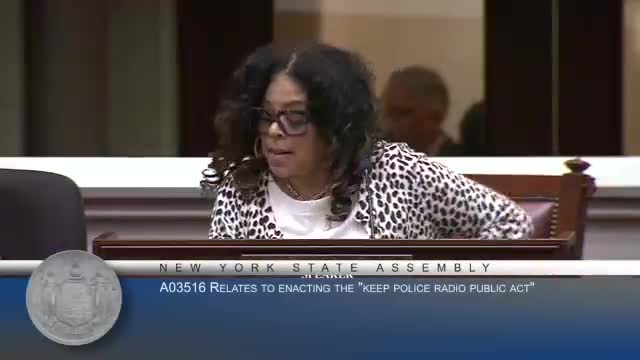New York legislators debate public safety concerns in law enforcement transparency bill
June 05, 2025 | 2025 Legislature NY, New York
This article was created by AI summarizing key points discussed. AI makes mistakes, so for full details and context, please refer to the video of the full meeting. Please report any errors so we can fix them. Report an error »

In a recent session of the New York Legislature, lawmakers engaged in a heated debate over a controversial bill concerning the regulation of law enforcement communications. The discussions highlighted significant concerns about public safety and the balance between transparency and the need for confidentiality in sensitive situations.
One of the primary points of contention was the potential risks associated with real-time broadcasting of police communications. Several legislators expressed fears that immediate access to such information could endanger lives, particularly in emergency scenarios. A key speaker argued for a slight delay in the transmission of sensitive information, suggesting that even a brief pause could allow law enforcement to manage potentially dangerous situations without compromising public safety. This perspective emphasized the need for a cautious approach to ensure that the public's right to know does not come at the expense of safety.
Critics of the bill raised questions about the role of the Department of State in regulating law enforcement communications, arguing that the agency lacks the necessary expertise to determine what constitutes sensitive information. They expressed skepticism about the bill's implications for larger law enforcement agencies, particularly regarding the financial burden of implementing encryption measures.
Supporters of the legislation, however, defended the need for transparency in law enforcement operations. They argued that timely access to information is crucial for journalists and the public, especially in urban areas where emergency services must respond quickly. Some legislators acknowledged the concerns raised by their colleagues but maintained that law enforcement is capable of discerning what information should remain confidential.
Ultimately, the bill passed with a narrow margin, reflecting the deep divisions among lawmakers on this issue. The outcome underscores the ongoing struggle to balance the public's right to information with the imperative of ensuring safety in potentially volatile situations. As the bill moves forward, its implementation will likely continue to be scrutinized, with calls for amendments to address the concerns raised during the debate.
One of the primary points of contention was the potential risks associated with real-time broadcasting of police communications. Several legislators expressed fears that immediate access to such information could endanger lives, particularly in emergency scenarios. A key speaker argued for a slight delay in the transmission of sensitive information, suggesting that even a brief pause could allow law enforcement to manage potentially dangerous situations without compromising public safety. This perspective emphasized the need for a cautious approach to ensure that the public's right to know does not come at the expense of safety.
Critics of the bill raised questions about the role of the Department of State in regulating law enforcement communications, arguing that the agency lacks the necessary expertise to determine what constitutes sensitive information. They expressed skepticism about the bill's implications for larger law enforcement agencies, particularly regarding the financial burden of implementing encryption measures.
Supporters of the legislation, however, defended the need for transparency in law enforcement operations. They argued that timely access to information is crucial for journalists and the public, especially in urban areas where emergency services must respond quickly. Some legislators acknowledged the concerns raised by their colleagues but maintained that law enforcement is capable of discerning what information should remain confidential.
Ultimately, the bill passed with a narrow margin, reflecting the deep divisions among lawmakers on this issue. The outcome underscores the ongoing struggle to balance the public's right to information with the imperative of ensuring safety in potentially volatile situations. As the bill moves forward, its implementation will likely continue to be scrutinized, with calls for amendments to address the concerns raised during the debate.
View full meeting
This article is based on a recent meeting—watch the full video and explore the complete transcript for deeper insights into the discussion.
View full meeting
